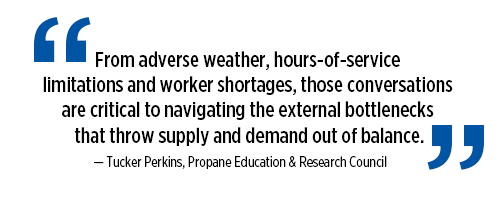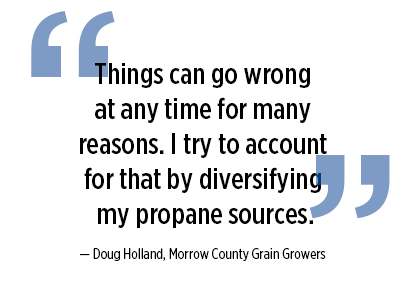 Doug Holland held his breath, hoping for good news. Scanning the weekly weather report, he looked for a break from the stretch of frigid weather that had settled on northern Oregon the month before. But the outlook for the rest of January 2017 was unchanged: bitterly, unseasonably cold. And more cold weather meant more logistical challenges for propane deliveries.
Doug Holland held his breath, hoping for good news. Scanning the weekly weather report, he looked for a break from the stretch of frigid weather that had settled on northern Oregon the month before. But the outlook for the rest of January 2017 was unchanged: bitterly, unseasonably cold. And more cold weather meant more logistical challenges for propane deliveries.
Avalanches and mudslides brought railcars coming from the north to a standstill. Poor road conditions left bobtail trucks arriving five days late. And all this after a wet harvest mixed with record corn yields already put increased pressure on propane supplies.
As the energy manager of Morrow County Grain Growers, Holland had spent the spring and summer months anticipating everything that could go wrong during the upcoming winter season. Now that everything was going wrong, it was time to see if his backup plans — and his cooperative’s local propane supply — could keep tanks from going empty during the bleakest cold spell in recent memory.
Keep lines of communication open
“The 2016 winter season started early and it didn’t quit,” says Holland. “Cold spells can strike our area at any time, so when storage is tight and supplies are low, your heart really gets pumping. From October to March, you’re on guard at all times.”
As Holland can attest, being on guard isn’t just a reactive process. In fact, the plans and relationships he had made ahead of time are what helped keep Morrow County propane tanks from going empty that winter. “Things were tight,” says Holland, “but we never did run out of propane. Our propane marketer helped us secure additional resources, plus some from other co-ops in our area who knew how dire the situation was. It really took people bending over backwards and watching out for each other to get through those tough times.”
Holland recognizes the adverse weather conditions that cause transportation delays are out of anyone’s control. But he maintains full autonomy over the contingency plans in place should things go awry.
“I always encourage propane suppliers, marketers and transporters to stay in constant contact about logistics ahead of the winter season,” says Tucker Perkins, president and CEO of the Propane Education & Research Council. “Be aware of each other’s plans and backup plans. From adverse weather, hours-of-service limitations and worker shortages, those conversations are critical to navigating the external bottlenecks that throw supply and demand out of balance.”
 It’s never too early to start thinking ahead, according to Holland. “Around February or March my mind is already in the next winter,” he says. He starts contacting suppliers in the spring and keeps at it through summer, making sure supply lines will be there when needed and that the five Morrow County storage sites can accommodate the deliveries.
It’s never too early to start thinking ahead, according to Holland. “Around February or March my mind is already in the next winter,” he says. He starts contacting suppliers in the spring and keeps at it through summer, making sure supply lines will be there when needed and that the five Morrow County storage sites can accommodate the deliveries.
Having partners that can supplement long-term thinking with real-time updates also helps. “Supply points in the Pacific Northwest are few and far between, so the entire region is heavily reliant on railcars,” says Les Klukas, account manager at CHS. “Logistics can be a challenge even in good weather, so sharing updates about transit times and delays as they happen helps Morrow County know what to plan for.”
Part of a propane supplier’s work leading up to winter should include conversations with customers to gauge expected propane consumption. “That includes something as big as the addition of a new heated building, down to a family member moving in who turns up the thermostat,” says Perkins.
Evaluate and adjust storage capabilities
For some propane suppliers, these pre-winter preparations lead them to the realization that their facilities lack adequate storage capacity. For others, it’s when these winters are in full effect that right-sizing storage becomes an obvious need.
In Holland’s case, it was a mix of both. Though Morrow County made it through the tough Oregon winter of 2016–2017 without running out of propane, looking several seasons ahead meant greater preparation was needed. “Our service area is growing,” he says. “As we expand, some of our tanks won’t be large enough or won’t be in very beneficial locations.”
“The polar vortex of 2014 has become our benchmark for cold weather and industry performance,” says Perkins. “In terms of degree days, this most recent winter was the coldest since that benchmark. Thanks to increased storage volume and industry readiness, there was a smooth transition to cold weather, and we didn’t see the struggle for reliable supply this year.”
“There are always going to be logistical challenges during peak demand. Extra storage helps control the uncontrollable,” explains Klukas. “Suppliers who have extra storage and go into winter with full tanks are the ones who can be most reliable for their customer base.”
However, installing new fuel tanks may not be in the budget. According to Klukas, that’s why CHS offers a unique program that lets customers pay that cost over time. “Our Storage for Pennies program makes the supply reliability of additional storage more attainable. With a modest up-front investment, propane suppliers can lease the equipment and pay for it over time with each gallon purchased.”
During summer 2018, Holland worked with Klukas to upgrade one of their locations with a 30,000-gallon tank through Storage for Pennies. “A long winter put us to the test almost immediately,” says Holland. “We’re already looking at using Storage for Pennies to expand capacity at some of our other facilities.”
Upgrading storage equipment also offers the benefit of financial flexibility. Longer periods of time between refills allows suppliers to purchase propane when they feel the price is best, says Perkins.

Secure propane supply from multiple sources
Regardless of season, the propane industry is fraught with uncertainty. But propane suppliers that strengthen the diversity of their supply lines can bring order to a historically volatile market.
For Holland, working with CHS to make connections in other markets helped him make it through Oregon’s toughest winter in recent memory. “Things can go wrong at any time for many reasons. I try to account for that by diversifying my propane sources,” he says. “If one rail system goes down, I have other options that can come from different directions. During the 2016–2017 winter, that meant trucking in supply all the way from California and Utah.”
 “It’s a fairly common occurrence that we’re problem-solving with customers and finding them additional supply sources,” says Klukas. “We have a network of terminals across the country and can divert or redirect supply to areas of higher urgency if needed. And if we don’t have sufficient supply, we’ll work with other propane marketers who do because we want to be good, reliable partners.”
“It’s a fairly common occurrence that we’re problem-solving with customers and finding them additional supply sources,” says Klukas. “We have a network of terminals across the country and can divert or redirect supply to areas of higher urgency if needed. And if we don’t have sufficient supply, we’ll work with other propane marketers who do because we want to be good, reliable partners.”
Holland believes an effective partnership is a two-way street. “Being the co-op that only reaches out once in a great while when the weather gets bad is not an effective way of doing business,” he says. “We make sure to work with people on a consistent basis to maintain that relationship.”
Reflecting on how the challenge of propane reliability has shifted from one year to the next, Holland recognizes that the element of unpredictability can never be fully eliminated. With sufficient preparation, however, it can be accounted for.
“I’ll admit, sometimes it felt like we were scrambling from one day to the next to get through that brutal winter, but we made it,” he says. “Having extra storage now means I don’t have to obsess about where the next load of propane comes from or when it arrives. We don’t typically get much notice before Mother Nature hits, but next time it does we’ll be ready to go.”
To learn more about how Storage for Pennies can help you save on right-sizing your propane storage capacity, visit CHSPropaneInsights.com.
This page was produced by North Coast Media’s content marketing staff in collaboration with CHS. NCM Content Marketing connects marketers to audiences and delivers industry trends, business tips and product information. The LP Gas editorial staff did not create this content.
All images provided by CHS













